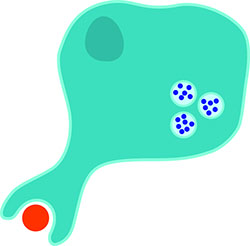
How Do Cells Eat?
Just like you, unicellular creatures need to eat. Unlike you, unicellular creatures don’t have mouths to eat with, teeth to chew with, or stomachs to digest with.
Cells eat other cells by engulfing them inside their cell membrane. This is called phagocytosis. The cell membrane of the predator cell will fold in or extend out to wrap itself around the prey cell. Once engulphed, the prey cell is contained within a special membrane-bound compartment called a phagosome. The predator cell can fill the phagosome with digestive enzymes to digest whatever prey is inside. Yum.
Below are two videos of predatory unicellular organisms; a ciliate and a heliozoan. When you watch the videos, take a look at how both predator cells have evolved structures that allow them to sense and catch their prey. Once caught, the prey is phagocytosed.
Sometimes these microscopic meals don’t behave as expected. Some cells, once they have been eaten, have the ability to evade the host’s digestive system. They can then live within the predator cell as a parasite, or as an endosymbiont.
| Here, a ciliate eats several passing flagellates. Though the video is too fast and small to see it, this ciliate is eating these flagellates through the same process of phagocytosis. |
| In this video, a heliozoan takes in another cell through phagocytosis. This happens on the lower right side of the heliozoan. |
Videos by Sally Warring. Macrophage image by Carolina Coelho.
Read more about: Cells Living in Cells
Bibliographic details:
- Article: How Do Cells Eat?
- Author(s): Dr. Biology
- Publisher: Arizona State University School of Life Sciences Ask A Biologist
- Site name: ASU - Ask A Biologist
- Date published:
- Date accessed:
- Link: https://askabiologist.asu.edu/how-do-cells-eat
APA Style
Dr. Biology. (). How Do Cells Eat?. ASU - Ask A Biologist. Retrieved from https://askabiologist.asu.edu/how-do-cells-eat
Chicago Manual of Style
Dr. Biology. "How Do Cells Eat?". ASU - Ask A Biologist. . https://askabiologist.asu.edu/how-do-cells-eat
Dr. Biology. "How Do Cells Eat?". ASU - Ask A Biologist. . ASU - Ask A Biologist, Web. https://askabiologist.asu.edu/how-do-cells-eat
MLA 2017 Style

Phagocytosis in action: Here, a macrophage (stained blue) has engulphed a fungal cell (light yellow). Next, it will release digestive enzymes into the area holding the fungal cell to kill the cell.
Be Part of
Ask A Biologist
By volunteering, or simply sending us feedback on the site. Scientists, teachers, writers, illustrators, and translators are all important to the program. If you are interested in helping with the website we have a Volunteers page to get the process started.

